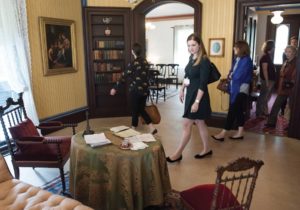Breathing New Life into the Homes of Hartford’s Literary Elites
EVENTS > SYMPOSIA
In Review: The Decorative Arts Trust Fall Symposium, 2017
Established in 1635 and once home to notable figures such as Oliver Ellsworth, Samuel Colt, Mark Twain, and Harriet Beecher Stowe, Hartford suffers from no shortage of vibrant history. Today, the city possesses many cultural stewards who work to preserve and interpret the legacy of these prominent personages. Trust members had the opportunity to appreciate this heritage firsthand through expert lectures and visits to numerous museums and historic sites throughout our 2017 fall symposium.
The collections and curatorial talent at the Wadsworth Atheneum and Connecticut Historical Society were met with great acclaim, but outings to the former homes of Stowe and Twain served as particularly unique examples of the community’s strong preservation legacy. Situated in the Nook Hill neighborhood, the Harriet Beecher Stowe Center and the Mark Twain House showcase the collecting and decorating habits of the two 19th-century literary icons during their residency in Hartford. Twain and Stowe were friends and neighbors who took very different approaches to adorning their homes. Visitors are able to tour these dwellings thanks to the vision and efforts of Stowe’s grandniece, Katharine Seymour Day, who acquired the two properties in 1927 to save them from imminent redevelopment. She led the way for future curators to preserve the rich past of these landmark historic sites. In the years since Seymour Day’s purchase, curators have been hard at work returning the homes to their former glory.
Stowe’s modest Gothic-Victorian cottage was completed in 1873. Each of the rooms within the residence reflect Stowe’s design choices and her unique interests in decorative and fine arts. A striking observation when entering the house is the sheer quantity of Madonna portraits owned by the devout family, some of which were painted by Stowe, a mother to seven children.
The decorative arts also play an important role in the interpretation of Stowe’s home. An Empire mahogany secretary owned by the family is on view in the formal parlor, along with other souvenirs and novelties the family acquired from their travels throughout the US and abroad. However, the seminal item in the Stowe collection is the drop-leaf dining table given to the author as a wedding present and served as the writing desk on which she wrote portions of her famed novel Uncle Tom’s Cabin. The otherwise mundane table is prominently displayed in front of a screen against which passages from the book are projected.
In an effort to provide visitors with a historically accurate visualization of the home, the Harriet Beecher Stowe Center is in the midst of a massive overhaul. This renovation includes the installation of period-appropriate wallpaper, carpeting, and windows intended to replicate Stowe’s original interiors. A rare photograph of Stowe shown sitting in her drawing room played an important role for the curator and restoration team, as did numerous letters describing the home’s appearance and décor. The Stowe Center’s project is only in its early phase, but the progress members were able to witness this past September showed great promise for the final installation.
In stark contrast to the Stowes’ traditional dwelling, her neighbor Samuel Langhorne Clemens (a.k.a. Mark Twain) constructed a splendid residence fitting for his grand and gregarious character. In 1881, Twain used the financial success from the publication of The Adventures of Tom Sawyer to adorn his abode with every luxury. Twain’s wife Olivia “Livy” Clemens played a leading role in the oversight of their home’s enhancement program. That same year Livy commissioned Louis C. Tiffany & Co. and Associated Artists to decorate the rooms and hallways used for entertaining. Their interiors feature an eclectic mix of designs and furnishings that took inspiration from North-African woodwork to Chinese ceramics.
The Twain House has witnessed significant transformations in recent years and continues to undergo restoration. Since receiving official recognition as a National Historic Landmark in 1963, the former Clemens residence has slowly been returned to its halcyon days. Although the Twain House’s refurbishment program is further along than across the lawn at the Stowe house, there is still much work to be done. Most recently Chief Curator Tracy Brindle tackled the renovation of the guest room located to the left of the entryway on the first floor. The room displays refinished original mahogany paneling, period-specific furnishings, and fanciful patterned wallpaper designed by Candice Wheeler in 1880.
The continued preservation of both of these prominent Nook Hill homes showcase the genuine interest taken by the Hartford community to commemorate the history of two of its most noteworthy characters. Although there is still much work to be done, the Mark Twain House and the Harriet Beecher Stowe Center are well on their way to providing visitors with an accurate representation of their original state. Collectors, curators, preservationists, and decorative arts enthusiasts have always played a significant role in the Trust and we were delighted to learn about and be accompanied by the many Hartford has to offer.










